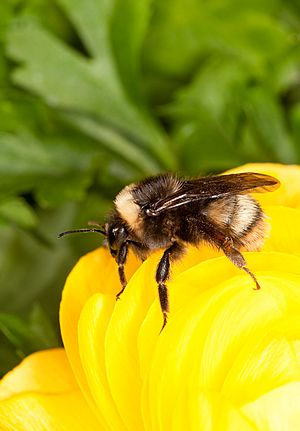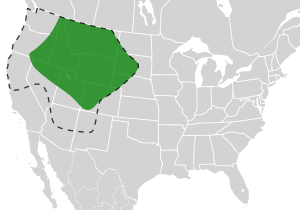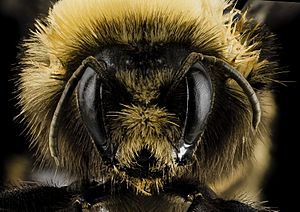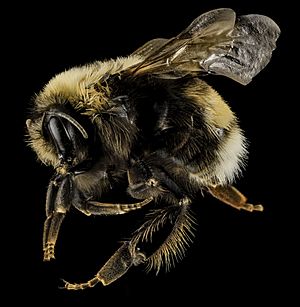Western bumblebee facts for kids
Quick facts for kids Western bumblebee |
|
|---|---|
 |
|
| Conservation status | |
| Scientific classification | |
| Genus: |
Bombus
|
| Species: |
occidentalis
|
 |
|
| The range of Bombus occidentalis. (Dashed line indicates former range within the United States (not Canada).) | |
The Bombus occidentalis, also known as the western bumblebee, is a type of bumblebee. It is one of about 30 bumblebee species found in the western United States and western Canada. Scientists have recently confirmed that it is its own unique species.
Contents
- Meet the Western Bumblebee: What It Looks Like
- Western Bumblebee Family Tree and DNA
- Where Western Bumblebees Live and Their Numbers
- Roles in the Bumblebee Colony
- The Western Bumblebee Life Cycle
- Western Bumblebee Behavior and Pollination
- Dangers to Western Bumblebees
- Protecting Western Bumblebees
- Why Western Bumblebees are Important to People
- Images for kids
Meet the Western Bumblebee: What It Looks Like
Western bumblebees can look a bit different depending on where they live. There are three main color patterns you might see.
Color Patterns of Western Bumblebees
The first color pattern is found in places like northern California, up to British Columbia, and east to Saskatchewan and Montana. These bees have yellow hair on the front part of their body, near their head (called the thorax). They also have black hair on the first part of their belly (the fourth abdominal segment). The lower edges of their fourth and fifth belly segments are whitish. Their sixth belly segment has thin whitish hairs that can look black, and their head is completely black.
The second color pattern is seen along the central coast of California. These bees have yellow hair on the sides of their second belly segment. All of their third belly segment is also yellow. Their fifth belly segment has reddish-brown hair.
The third color pattern is found from the Rocky Mountains all the way to Alaska. These bees have yellow hair on their thorax, right behind their wings. They also have yellow hair on the back of their second belly segment and all of their third belly segment.
How to Identify Bumblebees by Body Parts
All insects, including bumblebees, have three main body parts. These are the head, the thorax (middle part), and the abdomen (belly). When identifying different bumblebee species, scientists often look at the colors on their belly segments. These segments are numbered from T1 (closest to the thorax) to T6 for females, and T7 for males.
Telling Male and Female Western Bumblebees Apart
It's easy to tell if a western bumblebee is a male or a female. Male bumblebees, called drones, have seven belly segments. Females, which include queens and workers, only have six.
Another clue is their antennae. Drones have 13 segments on their antennae, while females have 12. Also, male bumblebees do not have stingers. Female bumblebees have wider, fatter back legs with a special "pollen basket" to carry pollen. Males have thinner back legs and no pollen baskets.
You can also tell by when you see them. Queens are the first to appear in spring. Workers show up after the queens. You can see all females throughout summer and into early fall. Drones only appear later in the summer and in early fall.
Western Bumblebee Family Tree and DNA
The western bumblebee belongs to the Insect class, the Hymenoptera order (which includes bees, wasps, and ants), and the Apidae family (which includes bees). Even though it is closely related to the yellow-banded bumblebee, DNA tests show they are different species.
Scientists have also found that western bumblebees might have two main groups: a northern group and a southern group. This is based on their DNA. The southern western bumblebees seem to have shorter hair than the northern ones.
Where Western Bumblebees Live and Their Numbers
The western bumblebee used to be very common in North America. They lived in many different places, from warm California to the cold Tundra regions of Alaska. This made them one of the bees with the largest living areas.
However, their numbers have dropped a lot recently. In the last ten years, the western bumblebee population has gone down by about 40%. This drop has been very big in California, western Oregon, and western Washington. Their living area has also shrunk by about 20%.
Some scientists think a parasite called Nosema is causing this decline. Others believe it might be because European honey bees moved into their areas. A study in 2016 suggested that the western bumblebee population might be growing again. This could be because they are becoming stronger against the Nosema parasite.
Roles in the Bumblebee Colony
Like most bumblebees, a western bumblebee colony has one queen, many female workers, and other bees that can reproduce. The queen's main job is to lay eggs. Worker bees stay with the queen and help raise more workers, and male and female reproductive bees. They feed the young bees (larvae).
Worker bees also fly out to find nectar and pollen. They also protect the colony from animals that might try to harm it. Only the female bees that can reproduce, called gynes, survive the winter. They have the chance to become new queens and start their own colonies next spring. They need to find a safe place to sleep through the winter.
The Western Bumblebee Life Cycle
A new western bumblebee colony usually starts in early spring. A single queen begins the process. First, she finds a good place for a nest. Like other bumblebees, western bumblebees often build their nests underground. They might use holes left by rodents or other animals. The queen then builds a wax structure and collects pollen. She uses this pollen to create a mass where she will lay her eggs.
When the first group of female workers grow up, they take over many jobs. They go out to find nectar and pollen, protect the nest, and feed the young bees. The queen's only job at this point is to lay more eggs. A western bumblebee colony can grow very large, with up to about 1,600 workers. This is a big colony compared to other bumblebee species.
The colony is active from early February to late November. Then, around early fall, the bees that can reproduce (new queens and males) are born. When winter arrives, the old queen, all the workers, and the males die. Only the young gynes (future queens) survive. They search for a safe place to hibernate until spring.
Western Bumblebee Behavior and Pollination
Western bumblebees are "generalist foragers." This means they don't rely on just one type of flower. Because of this, they are excellent pollinators. Bumblebees can also fly in cooler weather and closer to the ground than many other bees.
They also do something special called "buzz pollination." This is when a bumblebee grabs a flower's pollen-producing part with her jaws. Then, she vibrates her wing muscles. This shaking helps release pollen that would otherwise stay stuck inside the flower. Plants like tomatoes, peppers, and cranberries need this type of pollination. Because of these reasons, bumblebees are often better pollinators than honey bees. Western bumblebees have even been raised by people to pollinate crops like alfalfa, avocados, apples, cherries, blackberries, cranberries, and blueberries.
Worker bees collect nectar and bring it back to the nest. They then spit it out (this is called regurgitation). They also collect pollen and put it into special "pollen baskets" on their back legs. Nectar gives them energy (carbohydrates), and pollen gives them important nutrients (protein).
How Western Bumblebees Find Food
Western bumblebees are social bees. If a bee finds a lot of good nectar and brings it back to the nest, it can encourage other bees to go out and look for food too. This is called 'foraging activation'. However, unlike some other bees, they can't tell their friends exactly where the good food is.
The more good nectar a bee brings back, the more it encourages others to forage. Scientists are not sure exactly how this works. It might be that the returning bee releases a special scent that makes others want to go out. Or, maybe seeing a lot of good nectar suddenly come into the nest makes them want to find more.
Even though they can't share exact locations, it seems they can share what kind of flower was good. If a bee brings back nectar from a certain flower, other bees might prefer to look for that same flower.
Nectar Robbing Behavior
Sometimes, western bumblebees show a behavior called "nectar robbing." This happens when they get nectar from a flower without touching the parts of the flower that help with pollination. Western bumblebees sometimes do this because their tongues are short. Instead of going the normal way into the flower, they use their jaws to make holes in the flower to get the nectar. Because of this, their jaws are stronger and have more teeth than other bumblebee species.
Why Nectar is So Important
It is very important for a western bumblebee colony to have a lot of nectar stored. The amount of nectar affects the temperature inside the nest. If there isn't enough nectar, the bees can become low on energy. This changes their behavior. When colonies have plenty of energy and are threatened by predators, they make loud noises to scare them away. But if they have low energy, they will stay still in their nests. While short periods of low energy don't harm the young bees, it makes the colony more open to predators. It also makes the young bees take longer to grow up.
How Queens Recognize Their Own Young
Western bumblebee queens can tell if a group of young bees (brood) is their own or from another colony. When a queen lands on a group of young bees, she acts differently depending on if it's her own. If it's a foreign brood, queens will spend much more time checking the surface of the young bees with their antennae.
If a queen realizes the young bees are not hers, she is more likely to leave that spot. However, she will usually stay close to the foreign nest. She might fly short circles around the entrance before going back in. Most queens will choose to take over the new colony instead of leaving it. The worker bees in the foreign colony will then start working for the new queen. On the other hand, queens that return to their own nests will start taking care of their young and putting honey on them much faster.
Some scientists think this ability to recognize young bees developed to help them against other bees trying to take over their nests or parasites. Western bumblebees often face other bees trying to take over their nests, and they also deal with parasitic Psithyrus bees. It's possible that recognizing their young helps them adapt to these threats. Others believe that this ability is just a side effect of how social bees like the western bumblebee work. For social insects, it's very important to recognize their own colony members. The queen might have simply learned to recognize strange smells, which also helps her recognize foreign young bees.
Dangers to Western Bumblebees
Many things can threaten western bumblebees:
- Diseases spread by bumblebees raised by people for commercial use.
- Other pests and diseases.
- Changes to their habitat that can ruin their food supply or nesting spots.
- Pesticides and insecticides, especially for bumblebees that nest underground.
- Invasive plants that compete with the native flowers they need for food.
- Natural cycles of pests or predators.
Protecting Western Bumblebees
Bumblebees are very important pollinators. If their populations disappear, it can have big effects on the environment. The western bumblebee used to live in a wide area, including northern California, Oregon, Washington, Alaska, Idaho, Montana, western Nebraska, western North Dakota, western South Dakota, Wyoming, Utah, Colorado, northern Arizona, and New Mexico. But since 1998, their numbers have been going down.
The biggest drops have been in western and central California, western Oregon, western Washington, and British Columbia. In some areas, like from southern British Columbia to central California, they have almost disappeared.
Farms and cities growing have caused bumblebee habitats to become broken up. All bumblebee species have small populations because of how they reproduce. This makes them more likely to have inbreeding, which reduces the variety in their genes. This can increase the risk of their populations declining even more.
Between 1992 and 1994, western bumblebees and B. impatiens (another bumblebee species) were raised by people to pollinate crops. They were sent to Europe and then shipped back. A bumblebee expert, Dr. Robbin Thorp, thinks that their decline might be partly due to a disease they caught from a European bee while they were all being raised together. North American bumblebees would not have been strong against this disease before. When they came back to North America, the sick bumblebees spread the disease to wild populations.
Western bumblebees and B. franklini were affected in the western United States. B. affinis and B. terricola were affected in the eastern United States. All four of these species have been declining since the 1990s. These four bumblebee species are also closely related. Dr. Thorp also thinks that B. impatiens might have carried the disease, and that different bumblebee species might react differently to diseases. In 2007, the National Research Council said that the main reason for the decline in native bumblebees seemed to be new fungi and parasites, like Nosema bombi and Crithidia bombi, that were brought in from other places.
Why Western Bumblebees are Important to People
As mentioned, western bumblebees were once used in greenhouses to help pollinate crops. They were especially important for tomatoes. One problem with using these bumblebees was that some bees would "drift" into other colonies. These drifting bees would stop working for their own colony and try to lay eggs in foreign colonies.
Also, because of not enough rules between states in America and Europe, the Nosema parasite became very common in western bumblebee populations. Now, western bumblebees are no longer raised or sold for commercial use because their numbers are dangerously low. Instead, B. impatiens bees are used.
Images for kids




